Suez - Italy
(Photos WS)
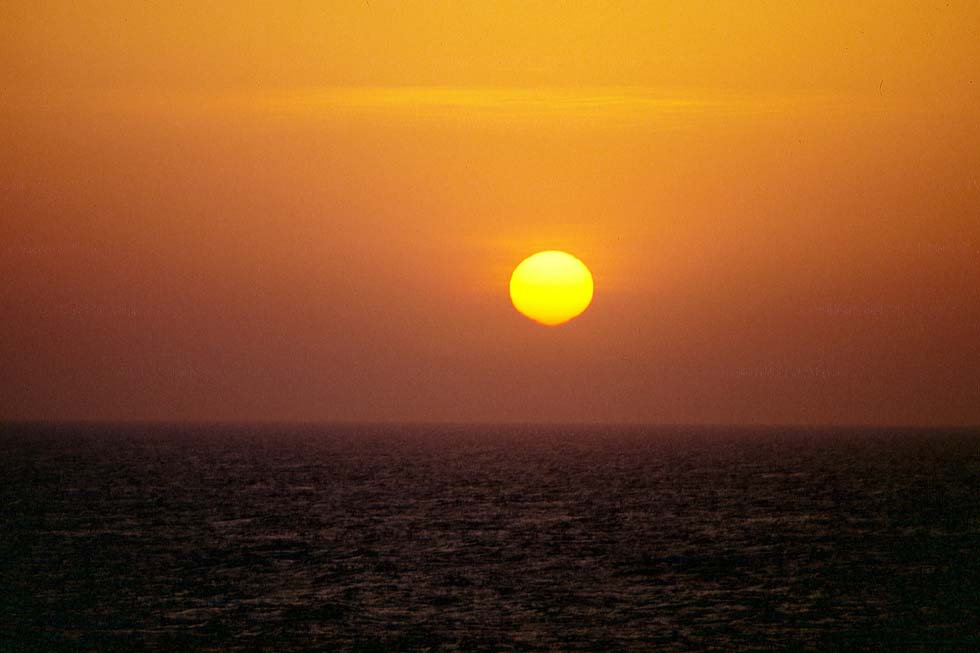
Red Sea
The “MSC Rhapsody” is heading northward through the Red Sea. The Bab el Mandeb Strait between Djibouti and the Yemen, separating Africa from Arabia, was passed on this Monday, the 16th of March 2009. The sea is calm and the day is sunny, though the climate is not as hot as it has been in the tropics half a week ago. On this evening a gala dinner takes place. The chef is surprising every day with exotic specialties, such as Asian, Arabian or Latin American dishes, and the guests like his cuisine.
During night hours the coast of Eritrea must have been passed, the arid country which is separating Ethiopia from the Red Sea. Next morning the Italian professor on board gives a lecture on the history and culture of the Hadj, the pilgrimage to the holy town of Mecca, of fundamental importance to the Muslims. Traditional port of embarkation for the pilgrims coming from North Africa or Asia is Jeddah. We must have passed this harbour, situated on starboard, while the coast of the Sudan is at port, both out of sight.
Third day since passing the Bab el Mandeb Strait: Onboard entertainment is going on and also the gambling for the deck chairs, always ‘occupied’ by towels placed there. The daily spectacle happens at 6 pm, when the golden sun is dipping into the dark turquoise-blue Red Sea.
For Thursday, 19 March, a call at Sharm el Sheikh is on the programme, replacing the initially planned stops at Safaga and Soukhna, officially caused on security reasons. Indeed it must be a safe place, for it’s the Egyptian naval base on the southeastern coast of the Sinai Peninsula, not far from Israel, Jordan and Saudi Arabia, the countries surrounding the Gulf of Aqaba.
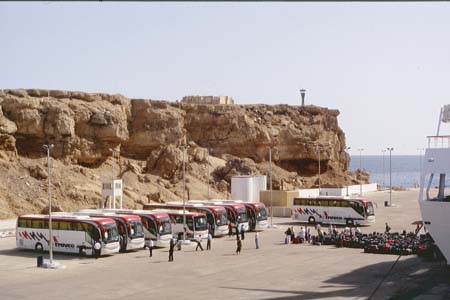 Sharm El-Sheikh harbour
Sharm El-Sheikh harbour
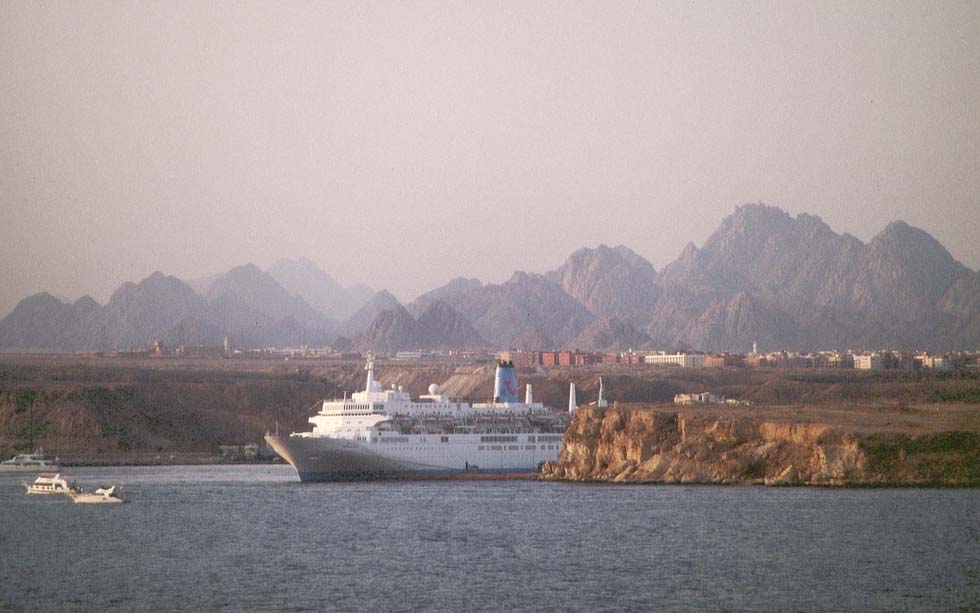
Sharm El-Sheikh and the “Thomson Spirit”
During breakfast time the “MSC Rhapsody” is already moored on the quay of the harbour bay, which had been upgraded for cruise ships and for ferries. The other vessels lying there are the “Thomson Spirit” of TUI Travel, (the former “Nieuw Amsterdam” of Holland America Line) and the tiny twin sisters “Athena” and “Artemis” of Overseas Adventure Travel. The blue waters of the bay are contrasting with the nearby steep rocks and the pyramids of the mountain ranges in the background, all this strange landscape simmering in the light-brown colour of a hostile stony desert. Only the white yachts and tourist boats in the bay are showing that Sharm el Sheikh has become an important resort of international and local tourism after a harsh time of wars: During the Suez conflict of 1967 it served as an Israeli outpost, until the Peace Treaty was concluded in 1979.
Walking past the friendly harbour police control along the new road crossing a nearby hill, the visitor is captured by the spectacle of another bay, this one amidst palm trees, strands and white houses, some hotels, restaurants, bars and the narrow lanes of a bazaar quarter. Of course the dealers are offering everything a tourist wants, they speak English, French, German, Italian and some shops even have signs in Russian. Beyond the next hill the new downtown is spreading, with Hilton, Sheraton and other renowned hotels, Volvo and Neoplan tourist buses filling the roads and jets of Egyptair and foreign airlines crossing the sky on the approach to Sharm el Sheikh airport in that peaceful year 2009. What a success story resulting from a peace treaty…
At 5 pm everybody must have boarded, the “MSC Rhapsody” moves off the quay without any tug assistance, people aboard the “Thomson Spirit” are waving a farewell and we leave the bay and the scenery of the bizarre mountain ranges, which in the centre of the peninsula are rising up to an altitude of almost 3,000 metres. That’s the place where Moses had received the Ten Commandments more than three thousand years ago. Finally the sun sets behind the last rocks near Ras Mohammed, the most southerly point of the Sinai Peninsula.
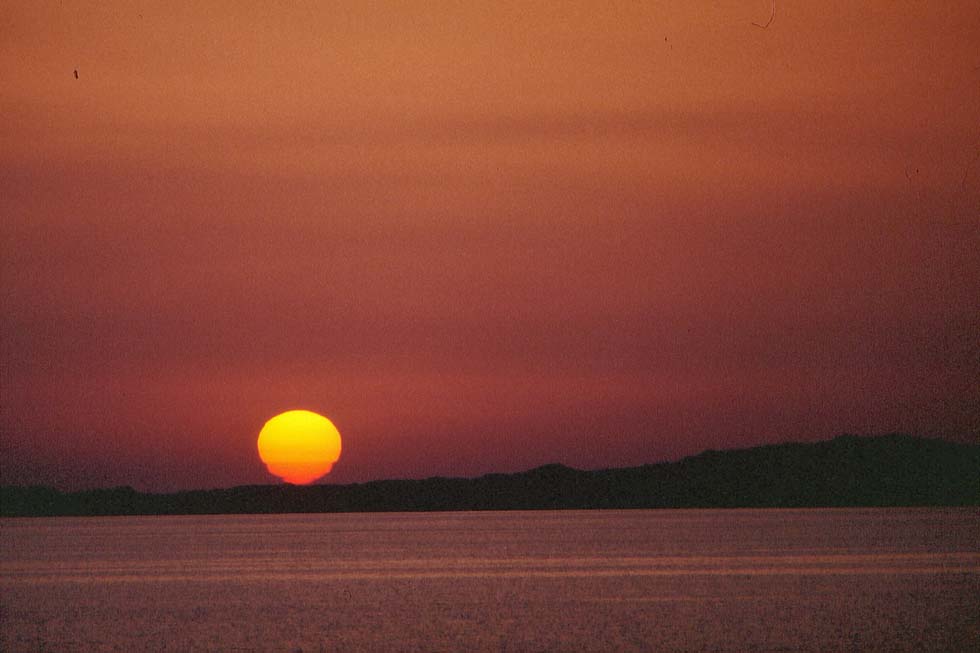
Ras Mohammed
In the evening an elegant sextet, including soprano, tenor and baritone, is presenting evergreens from Mama to Amapola, from O’paese d’ o sole to Funiculi Funicula. Could it not have been the same music decades ago aboard an Indian Ocean liner of Lloyd Triestino?
Friday, 20 March, 6 o’clock in the morning: it’s cool, sunrise had been hidden away behind clouds and the “MSC Rhapsody” is lying in the Bay of Suez, together with other vessels, around 20 or even more, mainly tankers and container ships. Pilot boats are swarming around and then the convoy enters the Suez Canal, that monument of modern history, completed in 1869. It’s an experience to cross Egypt slowly, at a speed of 8 knots, desert in the east, palm plantations and a few villages in the west. Sand dikes are framing the canal, interrupted by landing-stages for pontoons of the army in the neighbourhood of military camps. A few local ferries are crossing and somewhere there must be the only ‘undersea’ road tunnel, built in 1983. After 3 hours the turquoise-coloured water surface is widening, we enter the Little Bitter Lake and then the Great Bitter Lake. There around 20 vessels of the southbound convoy are waiting, the largest being the container ships of Maersk.
Decades ago, freighters of several nations were waiting here for eight years. The Suez Canal had been packed with scrap and mines in 1967 as a result of the ‘Six Days War’. For the ships there was no escape. Captains and crew members had to stay on board and they made the best of it. In 1968 they held their own ‘Olympics’, Polish, Germans, Norwegians peacefully united, politics didn’t concern. In 1973 they had to watch the air fights during the Yom Kippur War. Finally, after the Sinai peace agreement was arranged with help of U.S. Secretary of State Henry Kissinger, the canal was cleaned and in 1975 the ships could return home.
After having left the Great Bitter Lake, the canal is shrinking once again to the usual width of 200 to 300 metres. After an hour a huge old war memorial comes into view, shaped like a twin obelisk, and in the background the town of Ismailia is spread on the shores of Lake Timsah. The city, accommodating the headquarters of the canal administration, is looking clean, inviting and wealthy.
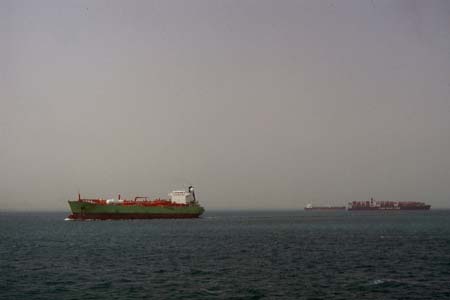
The Great Bitter Lake
|
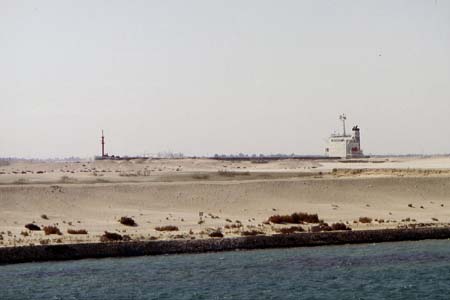
North of El Ferdan
|
After another hour the ship passes two strange iron structures, based on both sides of the canal. It’s the new swing span railway bridge of El Ferdan, completed by Thyssen-Krupp in 2001 (according to brochure). The timetable is listing a train Ismailia – El Qantara East – Rumana and informs: “Line to be extended to Rafa”. The first swing span bridge had been built in 1942 by the British, facing the German attacks from Libya. Crossing this old bridge, a direct Egyptian train Haifa – Cairo had been introduced, its steam locomotive sporting the label THE ORIENT EXPRESS, stopped in 1947 when she bridge was damaged by a ship. In 1953 a new bridge was opened, destroyed in 1956 by the “Suez Adventure”, but after Gaza had come under UN control in 1957, Cook’s timetable listed a train Cairo – Gaza. In 1965 a new El Ferdan bridge was completed by Krupp-Rheinhausen, it survived the “Six Days War’ of 1967, but the railway through the occupied Sinai Desert was abandoned due to sand storms.
North of El Ferdan the canal is divided. On the western arm the second southbound convoy is waiting, led by a big ro-ro vessel of Hoegh Autoliners. Hidden behind artificial sand dunes, the ships are looking like being stranded in the desert.
Once again united, the canal is leading toward a monument of our time, announced already by loudspeaker – the Peace Bridge, a gigantic road suspension bridge, built by the Japanese in cooperation with Egypt. In a breathtaking height of 70 metres the motorcars are crossing the canal.
Then the city of El Qantara passes by, children are waving and local ferries provide the connection with Qantara East. In 1918 a strategic railway bridge, with a large swinging pontoon section pivoted on the west side, was completed, but removed after the war. From 1921 until WWII, Qantara East was the terminus of the so-called “Cairo Express” from Haifa, a train of Palestine Railways and Wagons-Lits. Passengers took the ferry to Qantara West, where the wealthy could change to an ex-British “Pullman” saloon. The train should have become a link London – Cairo, a dream, never realized.
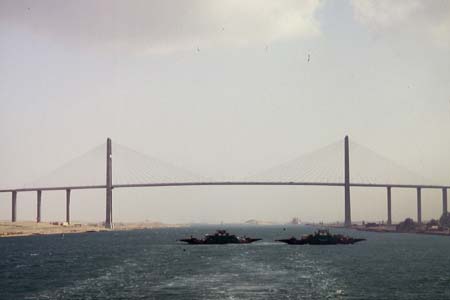
The Peace Bridge
|
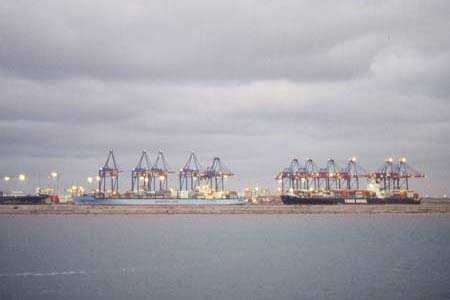
Container terminal near Port Said
|
The land in the west, once Lake Mensaleh, has been cultivated since decades. In the late afternoon a passenger train with a German-type diesel locomotive overtakes the “MSC Rhapsody”. It’s an express Cairo – Ismailia – Port Said. Parallel to the railway there is a motorway, densely frequented by cars, trucks and buses. The sky has become cloudy and evening is falling. The canal is divided up once again. Lights are spreading. A new container terminal, port facilities and, far distant in the west, minarets indicate that we are passing the region of Port Said. The pilot leaves, his boat blasts a farewell and then, after a canal passage of altogether 192 kilometers, covered in 12 hours at a fee of 150,000 euro, the “MSC Rhapsody” enters the Mediterranean. Goodbye Africa…
Next day the officers have changed their white uniforms against dark. Snowfall is reported from Zurich, but here in the Eastern Mediterranean region the sun is shining and the sea is blue. Not before dinner the first rain is falling. Are we going to meet the European winter now? No! We’ve an ‘Italian’ night, tenor Domingo Stasi is singing Bajazzo and then the cruise hostesses from Napoli are dancing Tarantella with the passengers (fortunately enough there had been a lesson before).
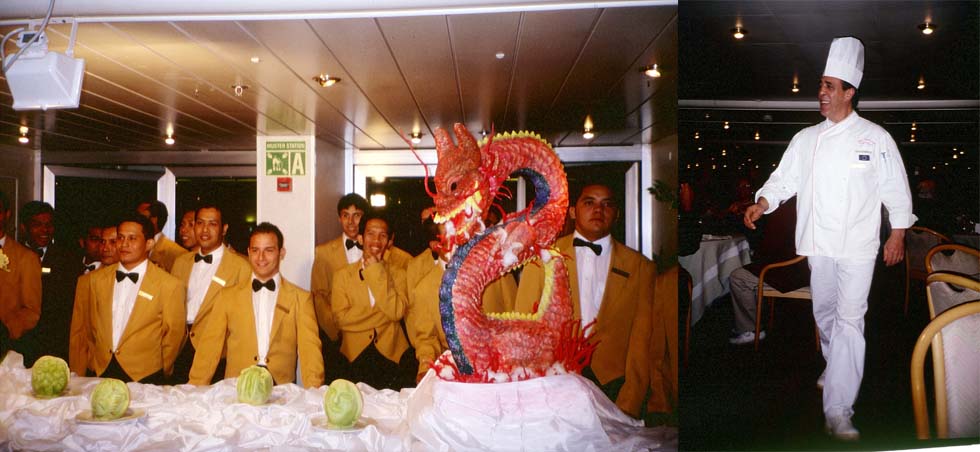
Farewell Dinner
During night the “MSC Rhapsody” continues ‘swinging’ in the rough sea… Thunderstorms near Crete and around the southern tip of the Peloponnese were reported. An intermediate stop on Crete island would have been nice and an aged Englishman agrees. “I have been there during the war”, he says (he must be 90 years old). On the ship in the public space and in the cabins it’s icy-cold. A fellow traveler tells his story of a cruise to Spitzbergen in the Arctic, gunmen protected the land excursionists against polar bears, temperature was a little above zero, but on board the ship, the “Amadea”, it was warm and comfortable (he travels together with his wife, she sitting in a wheelchair). Towards evening a rainbow is rising out of the sea … and the Captain opens the farewell party.
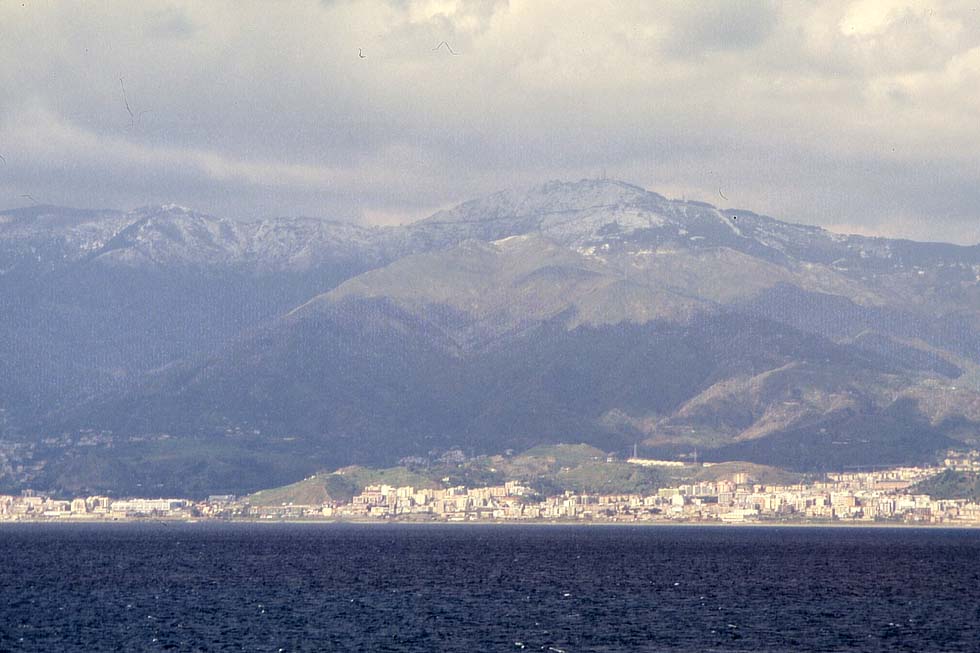
Sicily
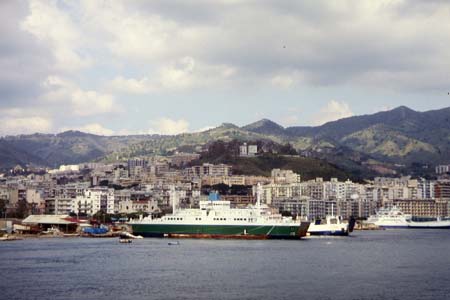
Messina and ferry “Ostfold”
|
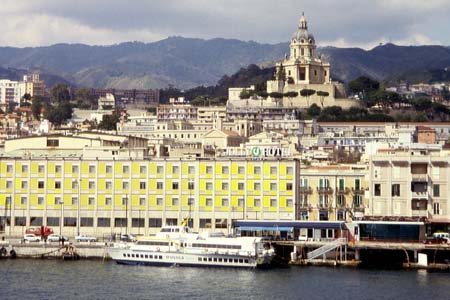
Messina and an Ustica hi-speed
|
Next morning the “MSC Rhapsody” enters silently the Strait of Messina, mountains of Italy to the right and mountains, the top covered with snow, to the left. That’s Sicily. Somewhere hidden by clouds must be the volcano Etna, more than 3,000 metres high. The houses and hotels of Taormina are spread along the coast and then Messina, buildings and churches leaning against the hills. Ferries of Bluvia and Caronte & Tourist to Villa San Giovanni on the mainland and a hi-speed of Ustica, coming from the Eolian Islands, are crossing the strait, while the “MSC Rhapsody” turns to port and enters the harbour, rounding the holy Colonna Votiva.
The harbour bay is crowded with ships, the “Maria Graziaon” of Moby Lines being the most spectacular one, outnumbered by the numerous Bluvia ferries of the Italian state railways FS. Their nice “Iginia” is leaving backwards. On the Stazione Marittima the “Villa” has arrived from Villa San Giovanni with the express train “Freccia della Laguna”, coming from Venice, being pulled into the Stazione Centrale by orange-coloured diesel shunters, divided up into a section each for Palermo and for Syracuse. A nice walk leads the visitor uphill and past innumerable churches to the cathedral, Il Duomo, an impressive holy place, the interior dark and grave. At 5:30 pm the passengers must have boarded the “MSC Rhapsody”. She leaves Sicily, the mountains topped with clouds, illuminated by the last rays of the setting sun. The lights from Messina, Villa San Giovanni and the Punta del Faro are left behind. Then once again an ‘Italian’ show is on the programme. Those wonderful nights are the experience aboard cruise ships, never to be expected in tourist resorts ashore. That is it what makes cruising “theatrical”…
The “MSC Rharpsody” has already left behind Capri island and the Gulf of Sorrento, when she’s moored on the quay of Napoli Stazione Marittima in the early morning, just in front of the car ferry “Campania” of Aliscafi SNAV, used on the Palermo route. Vessels of Caremar and Medmar enter the harbour bay, the Mount Vesuvius in the background. On the Molo Immacolatella Vecchia the “Raffaele Rubattino” of Tirrenia and then the “Trinacria” of TTT Lines, both employed on Sicily services, are overtopping the small vessels. In front of an old neo-baroque building a queue of trucks waits for embarkation. In the neighbouring Bacino Angionio the car ferry “Laurana” of Siremar is moored and the local boats of SNAV, Caremar and Volaviamare are arriving and departing.
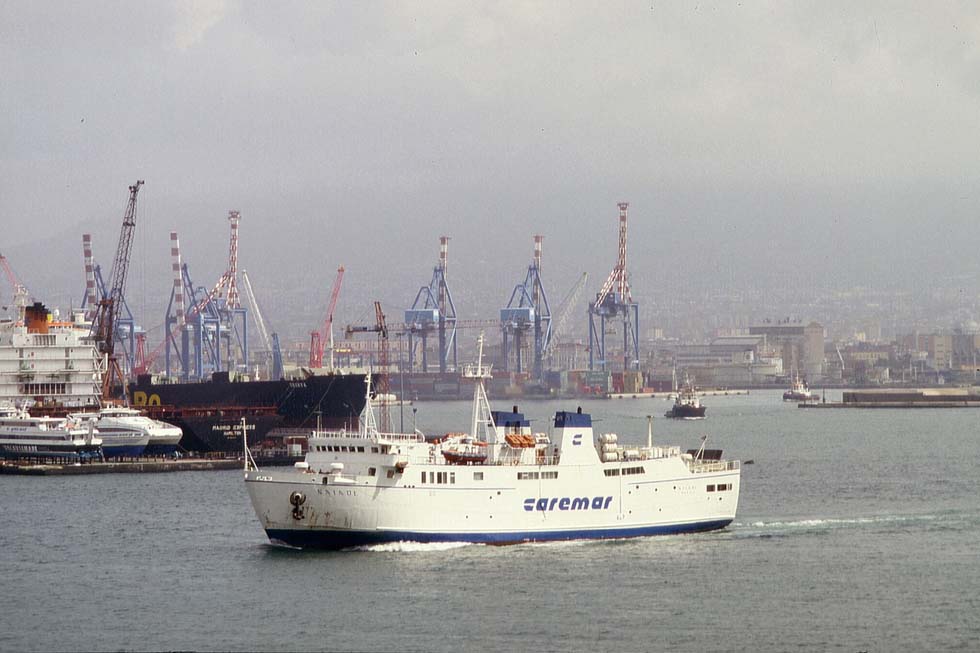
Naples and the ferry “Niade”
The visitor leaves the “MSC Rhapsody” at the ocean terminal of La Stazione Marittima, a representative building of the ‘30s, the interior designed in a light-flooded Art Deco style, once the terminus of the ocean liners. A walk through the city leads along the busy 19th century boulevards and the small old lanes, cramped with people, motorcars in endless traffic jams and the much quicker Vespa scooters, ignoring red traffic lights. That’s life, more Italian than anywhere else, that’s ‘italissimo’.
The last sightseeing buses arrive in a hurry after ‘blitz’ tours to the Vesuvius and Pompei. Then the “MSC Rhapsody” departs toward the Tyrrhenian Sea, passing some islands and the sea is getting rougher and rougher. Storm has been announced and passengers were informed that arrival at Genoa next day will be at 2 pm instead of 11am. A strong gale is blowing at more than 40 knots, the waves are rising up to 5 metres and the small ship is pitching on its northbound course.
Next morning is sunny and the sea has calmed down. Some melancholy is spreading as this wonderful voyage has almost reached its end. On 3rd March the “MSC Rhapsody” has departed at Durban, South Africa, covering the 7,510 nautical miles to her final destination Genoa within 22 days, 5 stops for sightseeing included. It is her last voyage for MSC, then she will be handed over to Mano of Israel to cruise as “Golden Iris”.
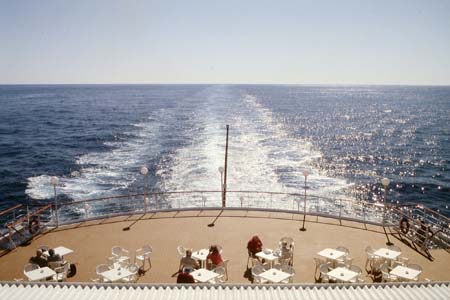
Mediterranean…
|
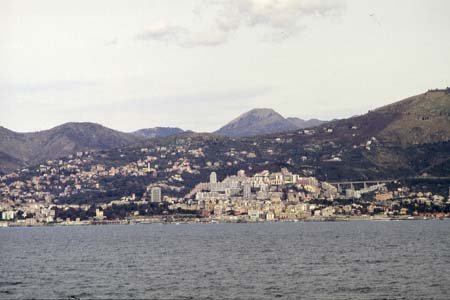
Genoa
|
Some islands are passing by. At port, in a very far distance, a white mountain is within sight. Could it be Cape Corse of Corsica? Later the mountain range of the Appennin accompanies the ship much closer at starboard, the tops snow-white. The Alps of the Riviera are appearing in the west, covered with even more snow. What a change of climate is it since departure in South African summer, crossing the humid tropics and arriving now in European late winter… The dark-green coast of Portofino is signaling that we are not far from Genoa and indeed the city, spread over hills, can already be seen.
Slowly the “MSC Rhapsody” is approaching the harbour, passing modern and old buildings, the cathedral and the palaces somewhere in the background. The ship enters the bay with the nice name Bacino delle Grazie, where the midsize cruise ship “Costa Romantica” is lying (though Costa Cruises’ terminal is Savona) and the “Tariq Ibn Ziyad” of Algerie Ferries is moored. Sailing round the Arena del Mare, a strange-looking black-painted vessel comes into view, the “F. Diamond” (identified as the 40 years old “Tor Hollandia”, then “Ariadne” of Minoan, “Ouranos” of Fragline, later an event ship). On the opposite side of the Bacino Porto Vecchio, the old harbour bay, close to the Terminal Traghetti, three modern car ferries are moored: the “Splendid” and the “Fantastic” of Grandi Navi Veloci, the latter employed on the Barcelona route, and the “Janas” of Tirrenia, serving Sardinia. At 2 pm the “MSC Rhapsody” arrives at the old Stazione Marittima, once the ocean liners’ terminal of Genoa.
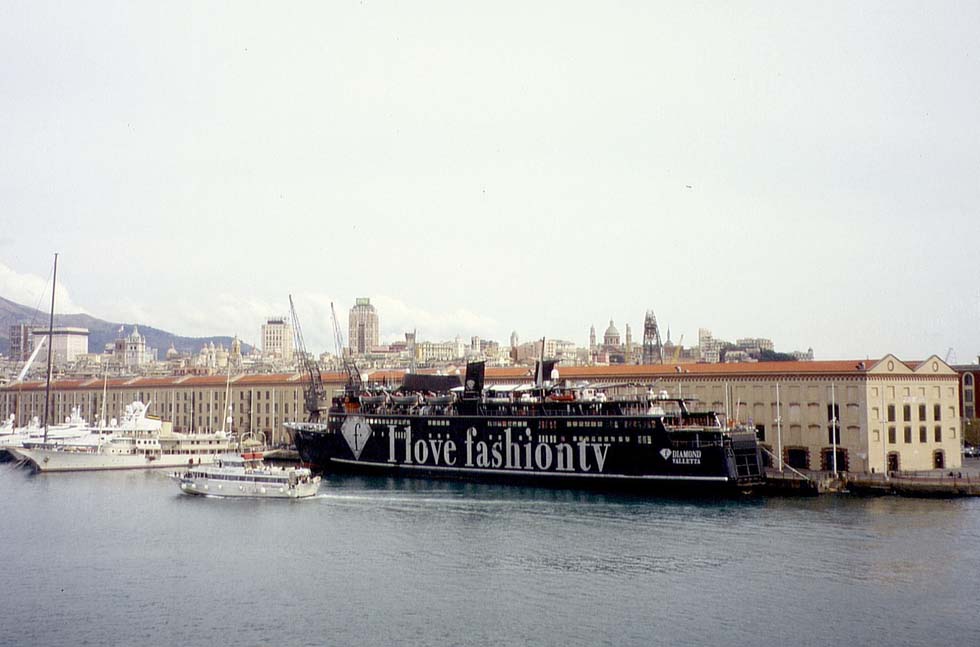
Genoa and the “F.Diamond”
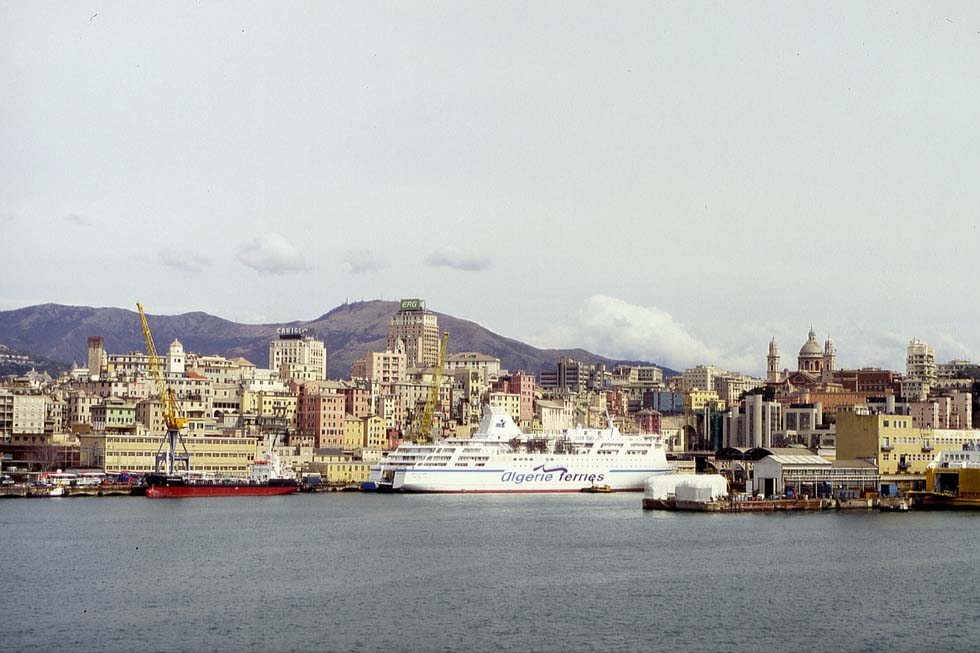
Genoa and the “Tariq Ibn Ziyad”, 2009
Due to the delay, caused by the gale last night, passengers having booked a connecting flight are disembarked first. Nevertheless an English lady, traveling alone, said sadly she has already lost the flight. A century ago, travelers had taken the de-luxe trains Rome-Express for Calais and Lloyd-Express for Hamburg. We have decided for a train ride homeward to Germany, too – but Italian railways are paralyzed by strike, us usual. Strolling along the splendid new harbour promenade (designed by Renzo Piano), admiring the cathedral San Lorenzo and the Palazzi, looking at the elegant fashion shops and enjoying Italian cuisine, the idea of being condemned to stay here for ever seems not too bad – in that city where Christopher Columbus was born...
|